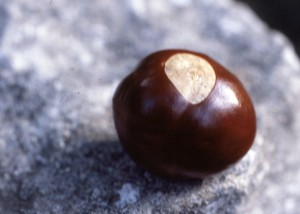In our previous post, we introduced the story of the Ohio Buckeye, the origin of the term ‘buckeye’, the tree’s scientific name (Aesculus glabra), its relationship with the OSU mascot, Brutus, and how it was introduced to football fans of Ohio in 1987. Here, we continue with the story of the buckeye, but with a different focus. We will show how the Ohio Buckeye is both similar and different from other buckeyes, discuss its habitat, flowers, fruits, and how you can grow your own buckeye in your backyard.
Diversity
Currently, there are 13 species of buckeyes in North America, Europe and Asia. Six species are native to the United States. In Ohio you can find two native and several cultivated species. All buckeyes have large compound leaves made up of 5 to 7 leaflets per leaf that radiate from the same point at the end of a leaf stalk. They range from large trees to shrubs. The native species are the Ohio Buckeye (Aesculus glabra) and the Yellow or Sweet Buckeye (Aesculus octandra).
Non-native species cultivated in Ohio include the European Horse Chestnut (Aesculus hippocastanum), and the southeastern US Red Buckeye (Aesculus pavia). Most species of buckeyes are bee pollinated; the Red Buckeye is hummingbird pollinated and its flowers are red and tubular. The hybrid between the Ohio Buckeye and the Sweet Buckeye, called Maryland Buckeye (Aesculus x marylandica), is also cultivated in Ohio.
Enjoy some photos of buckeye specimens in our collection:
- horse chestnut
- flower of horse chestnut
- red buckeye Aesculus pavia
- flowers of red buckeye
- Maryland buckeye Aesculus octandra x glabra
- red buckeye Aesculus x carnea
- yellow buckeye Aesculus octandra
- Flower of the yellow buckeye
Habitat
All buckeyes are found in woodlands and forests of various types, along riverbanks and floodplains. The introduced species and the hybrid plants make attractive trees in lawns, gardens, parks and on roadsides.
Flowers
The flowers are clustered together forming a cone-shaped panicle, a loosely branched inflorescence. They range in color from white (Horse Chestnut), to pale greenish yellow (Ohio Buckeyes), yellow or reddish (Sweet or Yellow Buckeye) to red (Red Buckeye).
Fruits
The fruits are leathery and open from the top when fully mature. In Ohio Buckeyes and Horse Chestnuts, the fruits are prickly due to short spiny outgrowths while in Sweet Buckeye, they are not. Despite similar fruits, Horse Chestnuts can easily be differentiated from Ohio Buckeyes based on the leaflets, which are mostly 7.
Properties
In the past, the seeds of the Ohio Buckeye were used as a source of oil for lamps, as an insecticide and as a paste for book binding. The wood was used in making bowls, spoons, handles and boxes. Since the wood is easy to carve, it was also used in making artificial limbs. Extracts from the bark were also used to dye leather. Today, the seeds are carried by some people as a good luck charm and they are treated in much the same way as a four-leafed clover. Some people also associate curative properties to the seeds, particularly for rheumatism.
Grow your own Buckeye
Buckeyes may be cultivated and propagated and can easily be propagated from seeds. Collect the seeds and do not allow them to dry out. Simply place several, fresh seeds, since not all may germinate, in shallow soil, about an inch deep. Gently press the soil down and keep them moist. Some seedlings will develop the next spring. If several seedlings come up, remove all except one so that this will develop into a tree. The seeds require three or more months of cold treatment (34-40 F) for good sprouting.
According to records, the Ohio Buckeye is not widely cultivated because “nurseries tend to emphasize the showier horse-chestnut, and perhaps also because of its poisonous properties (a few communities have even enacted ordinances prohibiting its cultivation). However, buckeyes make attractive and interesting landscape plants and are not hard to grow. One disadvantage is that the leaves tend to fall a bit earlier than [those of] other trees, especially in a dry summer, and, of course, the fruits and seeds drop to the ground below after they ripen. But they are not particularly difficult to remove from a lawn”.
- table of contents in the book “What is a Buckeye?” by John J. Furlow
- Ohio buckeye distribution map
- Occurrence map of Ohio Buckeye in each county of Ohio
References:
Cooperrider, T. S., A. W. Cusick, and J. T. Kartesz, (eds.), 2001. Seventh Catalog of the Vascular Plants of Ohio. Ohio State University Press, Columbus.
Furlow, John J. 1991. What is a Buckeye? The Story of the Ohio Buckeye Tree. The Ohio State University Herbarium. Unpublished ms.
Weishaupt, C. G. 1971. Vascular Plants of Ohio. Ed. 3. Kendall/Hunt Publishing Co., Dubuque, Iowa.
 About the Author: Mesfin Tadesse is Curator of Vascular Plants in the OSU Herbarium.
About the Author: Mesfin Tadesse is Curator of Vascular Plants in the OSU Herbarium.
*** We would like to hear from you – please leave a comment ***


























